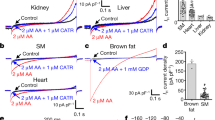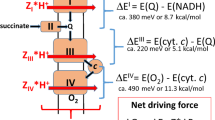Abstract
In mitochondria, ATP synthesis is coupled to oxygen consumption by the proton electrochemical gradient established across the mitochondrial inner membrane in a process termed oxidative phosphorylation. It has long been known from stoichiometric studies that ATP synthesis is not perfectly coupled to oxygen consumption. The major inefficiency in the system is leakage of protons across the mitochondrial inner membrane driven by the proton electrochemical gradient. The kinetics of the proton leak can be determined indirectly, by measuring the oxygen consumption of mitochondria under non‐phosphorylating conditions (plus oligomycin) as a function of the proton electrochemical gradient. This experimental system provides a convenient means to investigate inner membrane permeability to protons and the effect of factors that may effect that permeability. In this paper we review some results from our laboratory of indirect measurement of mitochondrial proton leak and how it has been applied to investigate the effect of aging, obesity and thyroid status on proton leak. The results show that (i) proton leak in isolated liver mitochondria is not significantly different in a comparison of young and old rats, in contrast (ii) there is an apparent increase in proton leak in in situ mitochondria in hepatocytes from old rats when compared to those from young rats, (iii) proton leak in neuronal mitochondria in situ in synaptosomes is not significantly different in young and old rats, (iv) proton leak is greater in isolated liver mitochondria from ob/ob mice compared to lean controls, (v) acute leptin (OB protein) administration restores the increased leak rate in isolated liver mitochondria from ob/ob mice to that of lean controls, (vi) administration of thyroid hormone (T3) increases proton leak in rat muscle mitochondria, and (vii) proton leak in muscle mitochondria is insensitive to the presence of GDP. It is proposed that the experimental system described here for measuring proton leak, is an ideal functional assay for determining whether the novel uncoupling proteins increase inner membrane permeability to protons.
This is a preview of subscription content, access via your institution
Access options
Subscribe to this journal
Receive 12 print issues and online access
$259.00 per year
only $21.58 per issue
Buy this article
- Purchase on Springer Link
- Instant access to full article PDF
Prices may be subject to local taxes which are calculated during checkout
Similar content being viewed by others
Author information
Authors and Affiliations
Corresponding author
Rights and permissions
About this article
Cite this article
Porter, R., Joyce, O., Farmer, M. et al. Indirect measurement of mitochondrial proton leak and its application. Int J Obes 23 (Suppl 6), S12–S18 (1999). https://doi.org/10.1038/sj.ijo.0800937
Published:
Issue Date:
DOI: https://doi.org/10.1038/sj.ijo.0800937
Keywords
This article is cited by
-
Cell-free ascites from ovarian cancer patients induces Warburg metabolism and cell proliferation through TGFβ-ERK signaling
GeroScience (2024)
-
Thyroid hormone inhibits lung fibrosis in mice by improving epithelial mitochondrial function
Nature Medicine (2018)
-
The metabolic rate of cultured muscle cells from hybrid Coturnix quail is intermediate to that of muscle cells from fast-growing and slow-growing Coturnix quail
Journal of Comparative Physiology B (2015)
-
Intravitreal delivery of AAV-NDI1 provides functional benefit in a murine model of Leber hereditary optic neuropathy
European Journal of Human Genetics (2013)
-
Fat and Water 1H MRI to Investigate Effects of Leptin in Obese Mice
Obesity (2009)



